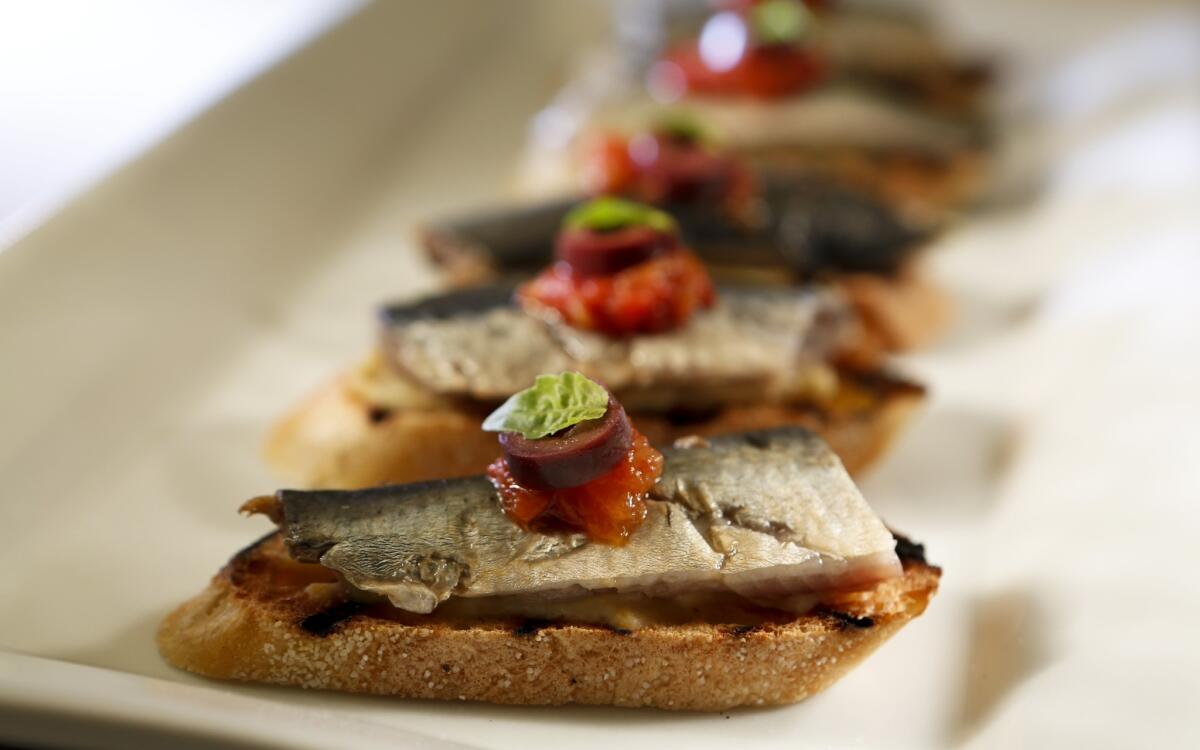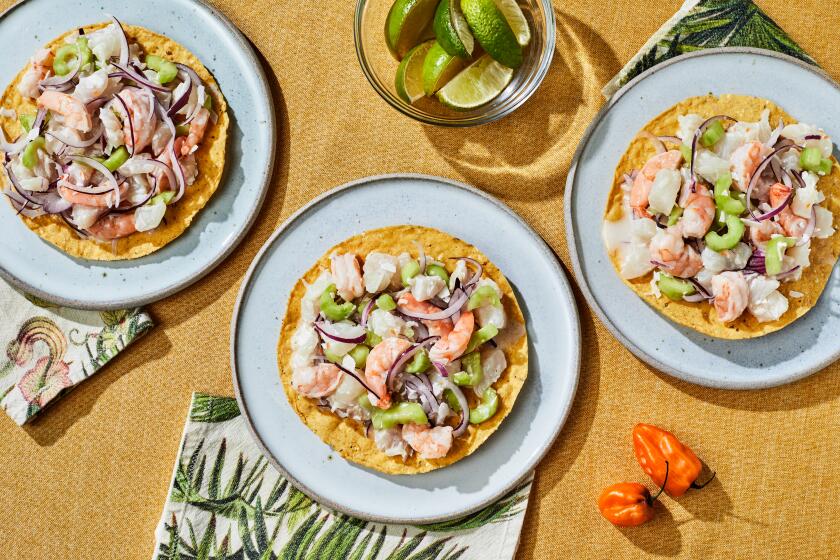Pickled sardines on toast with artichoke puree, tomato and black olive

Good things come in small packages. Sardines and mackerel are proof of this adage. These are fish for the converted, fish for people who truly enjoy the flavor of fish.
My first experience with fish of this sort came on a fishing trip in Maine when I was about 12. We were fishing freshwater, but we had brought along canned mackerel for quick lunches. I decided I’d try one. I turned the key on that little can and it opened up a whole world of briny, fatty deliciousness. I still love canned mackerel and canned sardines. Don’t get me started: Ever try a sardine bánh mì? No? Well, trust me, you’ve been missing out.
Sardines and mackerel are plentiful fish, whether you’re buying them canned or fresh. They are easy to come by and inexpensive. In a world where buying wild fish can be a minefield from a sustainability standpoint, these fish offer a haven, and a delicious haven it is.
When buying sardines, look for shiny, firm fish. They should still be flexed in rigor when you buy them, and make sure their bellies are intact.
Once you’ve found the sardines, you’ll need to decide what to do with them.
One of my very favorite dishes — one I could eat every day — is the pasta con le sarde we’ve served for years at Providence. It’s a play on a traditional Sicilian recipe. The pasta includes fresh sardines, olive oil, fennel, pine nuts, raisins and bread crumbs. It’s crave-worthy. Grilled sardines are also delicious with nothing more than sea salt and lemon.
Fish this flavorful does the heavy lifting; you really don’t need to do much in order to make them memorable.
If you want something that’s a little more involved and definitely dinner party material, try quickly pickling the sardines. Serve these on grilled slices of baguette you’ve smeared with artichoke purée and then top them with roasted tomatoes. It’s a terrific appetizer, or you could serve it with a big salad of arugula dressed with simple vinaigrette for more of a main course salad.
Really, any preparation that includes salt and a touch of acid will do: The salt to bring out the flavor in the fish and the acid to tame the fat. It’s hard to go wrong with sardines.
Mackerel is just as flavorful and easier to prepare, since it usually comes already scaled and filleted. I particularly like Spanish, or sierra, mackerel, which has a shiny spotted skin that does beautiful things when crisped in a pan or on a grill. This fish is also particularly abundant and inexpensive, and is recommended as a best choice based on sustainability by the Monterey Bay Aquarium.
One way I love to serve it during the summer is alongside a piperade, a slightly spicy mix of peppers, tomatoes and chorizo. This mixture works with all sorts of fish: mackerel, sardines, swordfish or bluefish.
Sardines and mackerel, like black licorice, aren’t for everybody. I get that, but you really need to give them a try. My son, one of the pickiest eaters on the planet, hounds me, nearly every Sunday, to take him to Park’s Barbeque for their broiled mackerel. Go figure. If he can relish them, so can you.
food@latimes.com
Roasted tomatoes
Heat the oven to 200 degrees.
Prepare the tomatoes: Score the skin at the base of each tomato with an X. Place the tomatoes in simmering water just until the skin starts to pull away at the base, about 30 seconds. Immediately remove the tomatoes and place in a bowl of ice water to stop the cooking process. When the tomatoes are cooled, peel the skins and halve the tomatoes crosswise (across the equator), then de-seed.
Choose a pan in which the tomatoes will fit in a single layer. Cover the bottom of the pan with a layer of olive oil, and place the tomatoes in the pan cut-side down. Place a half clove of garlic on each tomato half, along with a branch of thyme and half of a bay leaf. Season the tomatoes with a sprinkling of salt and pepper, then drizzle a little more olive oil over the tomatoes.
Place the tomatoes in the oven and cook for 3 to 4 hours. Baste the tomatoes with the olive oil every hour. The tomatoes will dry and intensify while in the oven.
When the tomatoes are done, remove them from the oil and place them on a plate, then put them in the refrigerator to cool.
When the tomatoes are cool, place them on a cutting board and finely chop them with a sharp knife. Place the tomatoes in a mixing bowl, and taste them for seasoning. Season with lemon zest and more salt and pepper if needed.
Pickled sardines
Rinse and scale the sardines, then eviscerate and fillet the fish. Sardines have lots of little bones; remove as many bones as you can from each fillet. The more you are able to remove, the more enjoyable they are. When sardines are cooked, this is less important than in a recipe like this, in which they’re pickled.
After the fish are filleted, season both sides with a generous sprinkling of sea salt and set aside on a plate. After 5 minutes, rinse the salt from the fillets with gently running cold tap water. Pat the fish dry with paper towels. Place the fish, skin-side down, on a parchment-lined rimmed baking sheet. Lightly drizzle the fillets with the rice vinegar, then place the sardines in the refrigerator for at least 30 minutes while you prepare the rest of the components.
Artichoke puree
Prepare the artichokes: Hold an artichoke in one hand with the stem facing toward you and the tip facing away. Peel or trim away the tough outer leaves. Keep peeling or trimming until you’ve cut away all of the leaves down to the heart and choke. Dip the artichoke into the acidulated water as needed to keep the cut surfaces from discoloring. With a paring knife, trim away the tip of the stem, then peel the stem and base of the artichoke, going from the tip to where the base meets the leaves. When you’re done, there should be no dark green tough spots left, only pale green and ivory. Remove the hairy choke in the center of the heart (a serrated grapefruit spoon is easiest; a teaspoon will work too). Cut each half into four pieces and place the pieces in the acidulated water. Repeat with the remaining artichokes.
Heat a stainless steel saucepan over medium heat with half the olive oil. Add the garlic, bay leaf and thyme. When they begin to sizzle, add the carrot and the drained artichokes. Stir the pan to coat all of the ingredients with the olive oil. Add a generous pinch of sea salt. Add the white wine, and cover the pan with a lid. Reduce the heat, and gently simmer the artichokes until they are tender, 15 to 20 minutes . Remove the herbs and the garlic and drain the artichokes, saving the liquid.
Place the artichokes in a blender along with the carrot. Purée the artichokes at high speed. Add the remaining olive oil. Add as much of the drained cooking liquid back into the purée as you need in order to make the purée smooth and luxurious. Season the purée with salt, then cover and refrigerate until needed.
Sardine canapes
Grill the baguette slices: Lightly brush the baguette slices with oil and place over a hot grill to toast. Grill the slices on both sides.
Score the fillets of the sardines by making cuts into the fillets at opposing angles in a crosshatch design to make the skins tender when eaten. Cut each fillet into two equal pieces.
Smear the toasted baguette croutons with a bit of the artichoke purée. Place a piece of sardine on each crouton. Season the fish with a pinch of sea salt. Place a tiny dollop of tomato on top of each crouton. Place a slice of olive on top of the tomato. Garnish each canapé with a tiny leaf of basil. Squeeze a drop or two of lemon juice onto each canapé, and serve immediately.
Get our Cooking newsletter.
Your roundup of inspiring recipes and kitchen tricks.
You may occasionally receive promotional content from the Los Angeles Times.















